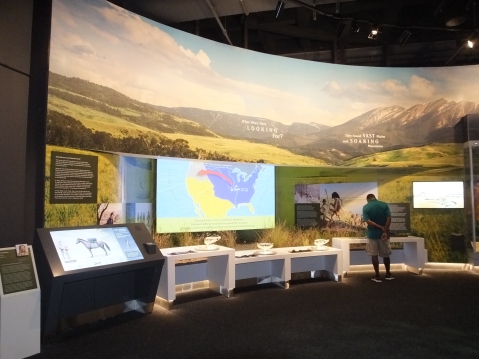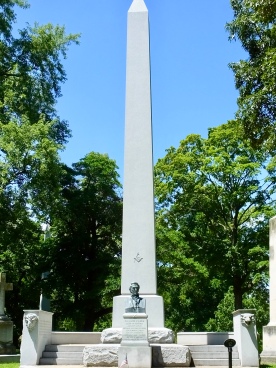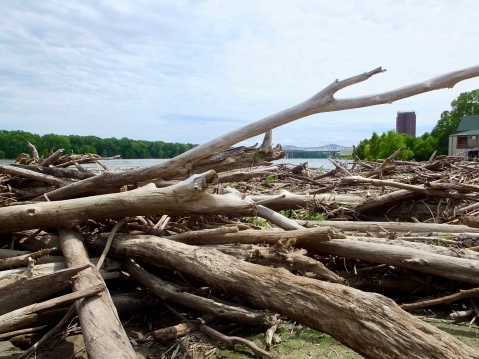MHT Day 5: The Corps’ Journey Begins
From the middle of December 1803 until the middle of May 1804, the captains made final arrangements for the historic voyage that would answer President Jefferson’s questions about a water route to the Pacific, the nature of the new land and its peoples acquired through the Louisiana Purchase, and the commercial and trade potential for the western portion of the United States. For Clark, that meant instilling military order and discipline to a permanent party that grew to 28 men. At the same time, he also had to determine the skills each man possessed and how they could be harnessed for the good of the party. Some of the recruits were well-behaved and reliable, while others needed to be molded by Clark’s firm hand before they could find a place in the Corps.
For Lewis, that five-month period meant spending much of his time several miles down stream in St. Louis or one of the nearby communities gathering additional supplies and working through the political tangles caused by Spanish occupation of French territory that was soon to be American soil. Although the Louisiana Purchase was ratified by the U.S. Senate in October 1803, the official transfer in St. Louis didn’t occur until March 1804 and involved the Spanish representative turning the territory over to the French who held it for one day before turning it over to the Americans. Lewis, still the private secretary to the President, was on hand to witness and sign the transfer document in March 1804. Firm possession of the Louisiana Purchase made an American military expedition up the Missouri River much easier, though little about the next two and a half years would be easy.
By May 1, the men of the Corps had gelled into a regular army unit and were ready to begin their voyage. Clark had them pack and repack the 55-foot keelboat which had been outfitted with additional storage lockers and prepare and pack the two pirogues (39 feet and 41 feet). They were, after all, taking with them about 12 tons of supplies.
On Monday, May 14, 1804, Clark wrote in his journal:
Set out from Camp River a Dubois at 4 oClock P. M. and proceded up the Missouris under Sail to the first Island in the Missouri and Camped on the upper point opposit a Creek on the South Side below a ledge of limestone rock Called Colewater, made 4½ miles, the Party Consisted of 2, Self one frenchman and 22 Men in the Boat of 20 ores, 1 Serjt. & 7 french in a large Perogue, a Corp and 6 Soldiers in a large Perogue. a Cloudy rainey day. wind from the N E. men in high Spirits
Finally, after years of planning, the Lewis and Clark Expedition was underway. Except that Lewis wasn’t with them. He was still in St. Louis and would join the group about 20 miles west at the village of St. Charles on May 20. OK, then the Lewis and Clark Expedition could get underway.

The Gateway Arch in St. Louis is hard to miss.
My day was spent at two locations in St. Louis and one in St. Charles learning about the St. Louis Lewis and Clark saw, the preparations they made, the craft they sailed (or rowed, or poled, or towed as conditions demanded), and the expedition leaders’ traits and personalities. First, I went to the iconic Gateway Arch, not to ride to the top to see the view from Missouri’s tallest structure, but to explore the interpretive museum at its base. Given a huge budget, experts can put together truly first-rate museum exhibits and the Gateway Arch museum is no exception. I discovered the history of St. Louis: Native American for thousands of years, then the Spanish to a small degree followed by the French who arrived both from Canada and by way of New Orleans, and finally the Americans. St. Louis itself was officially founded by the French in 1764 though its position at the confluence of the Missouri and Mississippi rivers had made it a Native American trading and commercial center for a thousand years. I pressed several park rangers into service to fill in some of the blanks not satisfied by the exhibits and left with a clearer understanding of frontier St. Louis and the international politics Lewis contended with.

Interactive exhibits and well-displayed artifacts abound in the Gateway Arch Museum.

William Clark showing a fine queue.
My next stop was Bellefontaine Cemetery (aka Bell Fountain in the anglicized patois), one of the city’s largest cemeteries with about 87,000 interments on 350 acres. Who was there that piqued my interest? General William Clark, who, after returning from his voyage with Lewis, was promoted to Brigadier General, named governor of Missouri Territory and appointed Superintendent of Indian Affairs for all land west of the Mississippi. Clark died in 1838 at age 68 after a long life as a soldier and a statesman. I read inscriptions on various memorial stones at the site, then sat for a while and reflected on what he and Lewis and their men had done. I concluded, like many others, that the ledger of his life had a mixed result. On the plus side, he was brave, honorable, fair, and sought justice for those in his charge.

Clark’s obelisk at Bellefontaine Cemetery. He is buried there with his second wife and three sons.
But at the same time the tragic results that his expedition helped accelerate for native cultures and thousands of native people cannot be understated. He knew what was happening as well as anyone, but was unable to alter the course of history he had helped set in motion. In 1825, he wrote to his old friend Thomas Jefferson, “It is to be lamented that the deplorable situation of the Indians do not receive more of the human feelings of the nation.”
Finally, I headed to St. Charles where the Corps stopped on its second day on the river to wait for its co-commander. In 2004, a group of re-enactors based in St. Charles but drawing its membership from far and wide, built and set sail in three accurately built replicas of the boats used by the Corps, going up the Missouri River to Mandan, North Dakota, in the keelboat and continuing on to Great Falls, Montana, in the two pirogues. Following their maiden voyage the boats were stored in a new boathouse and museum facility on the north bank of the Missouri River in St. Charles.
Several replicas of the keelboat will be available on my route west, but this was the first opportunity I had to see full-scale models of all three. Although the boats are not well-displayed for most visitors to see since the boathouse is mostly for storage of the boats, I met one of the re-enactors today who was hard at work cleaning up from this year’s flood, which deposited six feet of water and a foot of mud in the boathouse. He opened the heavy grated door and invited me to look around and see the boats in a way most visitors do not. We talked about the boats, their construction and their use, but we also talked about this year’s flood and how it compared to previous years’ floods. He reminded me that the Missouri River, when the Corps plied its waters, was much wider than now but much also much shallower. Constant dredging along the river’s course has deepened the channel and sped up the flow.

Some reminders of this year’s flooding line the bank next to the boathouse in St. Charles.
One final note: Today I visited two museums. One is well-funded by public monies and clearly the work of professional historians, exhibit designers and curators. The other is a volunteer effort maintained by donations and perhaps some small grants. The two were strikingly different, though each is important in its way and each helps preserve, interpret and display America’s past. I’m glad both exist and glad I was able to visit and learn at each of them.

Meriwether, Bill, Seaman and me in St. Charles. They were truly giants.

Glad to see that much of the history has been preserved and displayed
Pics of inside storage shed of the boats are great. Glad you were able to see them.
Pictures great as always. Interesting history you shared and replicas of boats amazing. Ride safe.
Enjoying your History lessons
Cool looking boats, lucky you to see them. What was life like on board ? I bet were bummed to have to leave them.